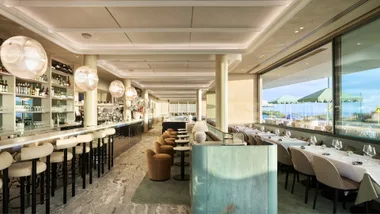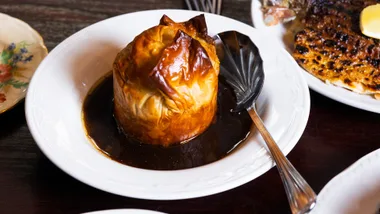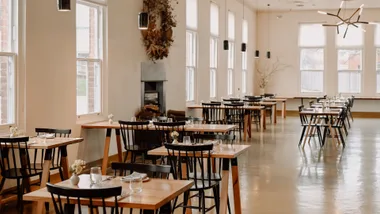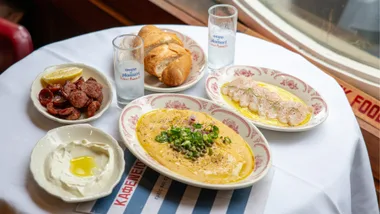Chaco Bar
238 Crown St, Darlinghurst, (02) 9007 8352
Licensed
Cards AE DC EFT MC V
Open Mon-Sat 6pm-10pm
Prices Entrées $7-$18, yakitori $3 per skewer, desserts $12
Vegetarian Three entrées, three yakitori
Noise Noisy
Wheelchair access No
Minus Tough to get in
Plus The yakitori benchmark
[Masu Izakaya
](http://www.masuizakaya.com) Shop B01/35-39 Liverpool St, Sydney, (02) 9261 3011
Licensed
Cards EFT MC V
Open Mon-Fri 11.30am-2.30pm, Sun-Thu 5pm-11pm, Fri & Sat 5pm-late
Prices Entrées $6-$14, yakitori $2.50-$7.50 per skewer, desserts $5
Vegetarian Six entrées, nine skewers
Noise Bearable
Wheelchair access No
Minus Amateur service
Plus Authentic vibe
[Tokyo Bird
](http://www.tokyobird.com.au) Shop 2, 226-228 Commonwealth St, Surry Hills, (02) 8880 0788
Licensed
Cards AE EFT MC V
Open Mon-Sat 5pm-midnight
Prices Snacks $5.50, yakitori $8 for two skewers
Vegetarian Five snacks, three yakitori
Noise Rockin’
Wheelchair access Yes, but the bar setting isn’t chair-friendly
Minus A relatively concise offering on the food front
Plus But an impressive booze offer, and snappy service
The best yakitori place in Japan is both strange and precise. Strange in its location – it’s just down from a dental practice in a tunnel that connects the Ginza station of the Tokyo subway with the street. Precise in just about everything else. As the queues form outside Bird Land for dinner at about a quarter to five, twigs of binchotan, the expensive charcoal made from Japanese oak, ring like glass as they’re rearranged on the narrow rectangular grills. Each prep chef works with a set of digital scales so each style of skewer weighs the same, the end of each piece squared off with care. The fridges are stocked with Taketsuru sake made to the restaurant’s specifications; owner Toshihiro Wada went to the trouble of bringing one of the brewery’s staff to work at Bird Land to make sure they had a true feel for the food.
And Wada is even more fearsomely exacting with the poultry he buys. Farmed in Ibaraki, the chickens’ meat is lean but juicy. Some skewers highlight just the bird’s oysters, or its wing; others combine cuts for contrast or harmony; and others still are threaded simply with gingko nuts or torch ginger. The skewers get dipped in a pot of tare, a sauce made to the secret recipe of each yakitori-ya, but usually based on shoyu and mirin. The approach to grilling is gentle: binchotan is prized more for the evenness of its heat than its intensity, and many yakitori chefs regard serious char as a fault, so a skewer of breast might be cooked so delicately that it ends up looking more poached than grilled. A set number of skewers is made each day – when they’re gone, that’s it.
If this seems like an awful lot of fuss to make about grilling chicken on sticks, by all means turn to my pal Michael Harden’s excellent Melbourne review in our June issue. He’s writing about the new Brooks, and there’s plenty of caviar and truffles in there. If you’re a true believer, though, or if you think you might be, come a little closer and let me tell you how Sydney’s yakitori game has stepped up in recent times.
We’ve had chicken on sticks for years now, of course, both at specialised venues and on larger, broader menus. Bird’s Nest in Brisbane does yakitori that’s more than credible, Melbourne’s protocol-shrouded Yu-u has kept the charcoal burning for more than a decade, and the luxed-up skewers on the bar menu at Sepia did plenty for the genre’s profile back home. But a clutch of Sydney yakitori bars all opened in the past 12 months has raised the stakes.
Chaco Bar was the first of these, and may still be the best. If small is beautiful in Japanese restaurant culture, Chaco is very comely indeed. Fukuoka-born chef Keita Abe opened it after he left the kitchen at Tokonoma on Crown Street, and the aesthetic contrast between the two restaurants is striking. Not much more than a handful of small tables around a longer central bench, Chaco has a pleasingly handmade quality. The ceiling is strung with bunting and cords for the lamps, the walls decorated with slats of timber listing menu items in kanji, the food passed, Play School-style, through a hatch from the kitchen. The large jars on the shelves aren’t merely decorative, but hold custard apples, quince and cumquats steeping in brandy for desserts to come. The air is alive with smoke from the bincho and gidgee charcoal-fuelled grill and chat.
The staff greet orders with a charming mixture of surprise and delight. It’s worth delving into the other entrées before the sticks for the texturally exciting and nicely spiced salad of tuna belly and finely chopped pig’s ear, or the festival of umami that is grilled jumbo asparagus dressed in a miso-anchovy butter.
The sticks are ordered singly, most of the chicken ones at four bucks a go, and come out as they’re cooked, so they’re as hot as possible, piled up on a plate of chopped raw cabbage (this is a Fukuoka thing, as is serving yakitori with ponzu) you share with the members of your party. If you’re prone, as I am, to over-ordering, they tend to sneak up on you – perhaps a few cubes of eggplant grilled to absolute surrender, daubed nasu-dengaku-style with miso and sesame, then juicy nuggets of thigh, again glazed with miso, and then a closely packed ruffle of chicken skin, sweet, with a little chew under the crisp exterior.
Yakitori bars in Japan are all about using just about every part of the bird, and of the new-wave Sydney places, Chaco cleaves the closest to this tradition, offering perhaps the largest number of offal options. Tail (aka bonjiri, aka parson’s nose) is sweet and crunches to the bite, a skewer of gristle (nankotsu, the triangular bit where the breasts meet on a roast; in Japan you’ll also see chicken knee gristle sold separately) all texture, crunchier still, while the pink-centred liver is handled with greater care than any other examples in town.
Hearts are a common (and delicious) feature of most yakitori menus, but Chaco goes a step further in also serving kokoro, translated in a not entirely appetising manner as “heart pipes”. They’re the aorta and other bits of trim from the heart and, rich and sweet, they’re something of a must, as is the wagyu tongue, which has a golden, cereal-fuelled taste.
Abe says bringing authentic yakitori to Sydney is very important to him, from the décor to the offal to the sake. “I want everyone to feel as if they are setting foot in Fukuoka themselves whenever they dine at Chaco Bar.”
There’s not much happening with wine (though BYO is an option), but the sake list is short and smart, and a wider-than-usual range of Japanese beers is offered. And those fruits steeping in booze? Whether it’s banana or green plum, they come out at the end in the short-and-sweet dessert offering, typically a variation on the theme of fruit-plus-granita-plus-ice-cream-equals-yay. Should you want to end things on a more Japanese note, hit the rice special of the night – a bowl topped with salmon roe, say, or sea urchin.
The two more recent entrants to Sydney’s culinary game of pick-up-sticks occupy different ends of the spectrum. Both have their charms.
Masu Izakaya, which opened in autumn, sticks to the Tokyo-sidestreet script. It’s a narrow two-storey affair, its decorative flourishes mostly confined to industrial brackets for hanging bulbs, electric fans, and the rope binding its ceiling pipes. The menu is packed with Japanese drinking food, be it charred dried skate wing (dense, sweet), takowasa (a gloopy bowl of cold raw octopus sharpened with wasabi and a slice of lemon) and “hot plate assorted chicken innards with garlic” (which I have yet to order), as well as the more pedestrian gyoza, edamame, karaage and nigiri sushi. Corn kernels sizzling in butter on an iron plate are precisely the sum of their parts, a special of little-neck clams steamed in sake is simple, generous and on point, while pieces of firm tofu topped with chilli paste, green onion and sesame are essential.
The yakitori, which is cooked over gas-fired charcoal, is solid. Owner Johnathan Lee and chef Yujiro Kuremoto are particularly proud of their tsukune and wagyu skewers. The tsukune, chicken meatballs a bit smaller than table-tennis balls, have a bit of gristle through the mince for texture, and are served heavily charred, primed for dipping in the traditional accompaniment of raw egg yolk, while the wagyu is simply a solid stick of juicy beef intensity. Wings come split, salted and paired with lemon, while thigh is grilled either straight, interleaved with chunks of leek, or – my favourite – topped with a squiggle of mentaiko, a deeply savoury cod roe sauce.
Don’t expect much in terms of interaction or guidance from the staff – Japanese is the dominant language on the floor – and the drinks list is tightly focused on beer (international industrial), sake (replete with Sake Meter Values on the list, indicating sweetness) and spirits (plenty of whisky plus a few shochus) rather than wine (a token effort).
Tokyo Bird, on the other hand, is all about the booze-juice. Set in an alleyway around the corner from Bodega, it’s the sort of place you could happily enjoy as a bar without engaging with so much as a feather of poultry. The music is hip, the drinks are strong and the service is savvy, all of which might be explained by the bar backgrounds of its principals, general manager Jason Ang (late of Gilt Lounge at the QT) and bar manager Yoshi Onishi (a veteran of The Victoria Room and Stitch).
Asahi and Asahi Black are here on tap, and the Highballs (Japan’s favourite way to drink whisky) are rockin’, but the cocktails are better still, whether it’s something from the nicely edited list of classics, which presents Whisky Sours and Dark and Stormys alongside Papa Dobles, or an Infiniti (a Rob Roy made with Nikka from the Barrel whisky in place of Scotch). A section of the menu is devoted to Old Fashioneds, and there’s a line advertising ice-ball carving classes. And yet the food is no afterthought.
The bar snacks aren’t as out-there as those you’ll find at Masu, and not as accomplished as what’s on offer at Chaco: edamame, pickles, school prawns. Katsu nuggets, for instance, are fried, served with mayo and forgotten almost immediately.
Far better to get your chicken on a stick. Like Masu, Tokyo Bird uses a Turkish brand of charcoal called Firebrand, but exercises a light hand on the grill. Chicken hearts are juicy and have none of the liverish mealiness that comes with overcooking, and the suggestion of sake in the tare along with the usual soy and mirin is very welcome. The hard-boiled quail eggs haven’t slipped into rubberiness, while cheese-sausage, which seems like a piece of izakaya-style stunt-casting, is a gooey guilty pleasure nonetheless.
Three venues doing their darnedest to popularise a pursuit centred around barbecues and downing beers in Sydney? It’s crazy, but it might just work. With establishments of this calibre getting behind the push, and with just about everyone in the world right now interested in dining that’s rigorous in the kitchen but relaxed in the dining room, yakitori stands every chance of being a welcome new part of our dining landscape.
.jpg?resize=877%2C1024)
Masu Izakaya’s clams in sake










